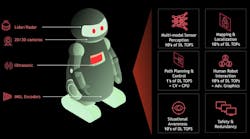Check out more coverage from GTC Fall 2022. This article is also part of the TechXchange: ROS: Robot Operating System
What you’ll learn
- The capabilities of the Jetson Orin Nano.
- The capabilities of the Nova Orin robot.
- Why running ROS is important.
NVIDIA’s DRIVE Thor delivers over 2,000 TOPS to help keep autonomous cars driving true. However, it tends to be overkill for many robotic applications that can simply benefit from a small-form-factor system-on-module (SOM). This is where the new Jetson Orin Nano comes into play (Fig. 1).
The Jetson Orin Nano is available with 4 or 8 GB of memory delivering 20 or 40 TOPS, respectively. Thus, it’s 80X faster than the earlier Jetson Nano. The large-capacity Jetson Orin Nano consumes 7 to 15 W, while the other uses 5 to 10 W of power. Software is compatible with the Jetson family, and the platform utilizes the same NVIDIA JetPack SDK and CUDA-X accelerated computing stack. Pricing for the module starts at $199.
Nova Orin is the company’s autonomous-mobile-robot (AMR) reference platform that’s about the same size as a Roomba robot vacuum cleaner (Fig. 2). It has six cameras, including two stereo cameras and four mono cameras. It also incorporates eight ultrasonic sensors and a pair of inertial measurement unit (IMU) sensors, providing 360-degree coverage. The robot is controlled by a Jetson Orin Nano.
The Nova Orin can now run the Robot Operating System 2 (ROS). ROS has become the de facto standard for AMR development. ROS 2 was used by the race cars in this year’s Indy Autonomous Challenge run at this year’s Consumer Electronics Show. ROS 2 also works with Micro-ROS, which operates on microcontrollers that often support smart sensors. The Nova Orin will be available soon.
Developers can check out their designs using the Isaac simulator powered by NVIDIA’s Omniverse. This can be downloaded to a local computer or run in the cloud (Fig. 3). A cloud-based solution enables large worlds to be simulated on demand without the need to invest in hardware.
The Omniverse supports the Omnigraph visual programming language (Fig. 4). The visual scripting and programming environment makes robotics applications easier to develop when using different compute nodes that are connected to each other.
Check out more coverage from GTC Fall 2022. Also read more articles in the TechXchange: ROS: Robot Operating System





